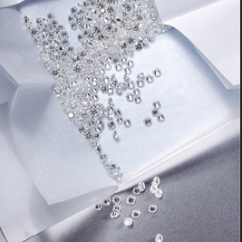Articles and News
Bain & Co. Report: Long Term Diamond Industry Fundamentals Good But Short Term Remains Challenging December 23, 2015 (0 comments)

Antwerp, Belgium—The fifth annual Bain & Co. report on the global diamond industry, prepared in conjunction with the Antwerp World Diamond Centre, was released on December 8. The report takes a comprehensive look at the major developments along the diamond value chain in 2015, focusing on the reasons for the recent drop in prices and continuing—but slowing—growth in the macro economy. The report also provides an update on the long-term outlook for the diamond industry through 2030.
In short, the long-term outlook for the market remains positive, but demand is not going to start outpacing supply until 2019. In the meantime, with the supply-demand balance remaining tight, look for continued pressure on margins.
Some key takeaways from the report:
In 2014 and the first half of 2015, revenue across the diamond industry value chain grew by 4% to 8%, as demand slowed in China while continuing to grow in the United States. Bain highlighted China’s slowing GDP as a potential risk in a previous edition of this report. Greater China’s diamond jewelry retail dynamics caused a decrease in demand for polished diamonds and, in turn, rough diamonds. The jewelry consumption spike in China in 2013 led to inflated expectations of growth that didn’t materialize, resulting in excess inventory throughout the diamond pipeline.
The Greater China diamond jewelry market appears to be in turbulence in the short term. The three largest retailers have posted significant year-over-year drops in diamond jewelry sales. The slowdown in China also has had a ripple effect throughout the diamond industry, which led to price decreases for polished and rough diamonds of 12% and 23%, respectively, since May 2014 and of 8% and 15%, respectively, since the beginning of 2015.
Bain believes that regular circulation of diamonds through the pipeline should be restored as soon as the midmarket and retail segments clear their excess inventories. This time, however, the market should return to its long-term growth trajectory more quickly than is the historical norm because of positive macroeconomic fundamentals. Conscious management of supply levels by rough-diamond producers and polished-diamond manufacturers is necessary for a sustained recovery.
Mid-market companies are being forced to reevaluate their business models. The segment is not robust enough to cushion against short-term fluctuations in the diamond jewelry retail market. It has little bargaining power over rough producers and retailers and limited access to financing, yet mid-market players unconsciously or deliberately bear risks and benefits of price volatility that their business models cannot support. Bain observes that the continuing development of the mid-market segment should enable the industry to implement more sustainable business models.
As in past years, the industry faces key challenges: sustaining long-term demand for diamonds in developed markets and among a new generation of consumers, and boosting demand from other sources than jewelry and aesthetic use. The risk of penetration of undisclosed synthetic diamonds persists but Bain sees no reason to believe that it will have any considerable impact on the market in the near future. One of the key industry priorities in 2016 for restoring a sustainable, healthy diamond pipeline will be to restore the midmarket segment’s profitability.
The long-term outlook for the diamond market remains positive, with demand expected to outpace supply starting in 2019. Until then, the rough-diamond supply-demand balance will be tight. We expect demand for rough diamonds to recover and return to about 3% to 4% growth per year on average, relying on strong fundamentals in the United States and the continued growth of the middle class in India and China. The supply of rough diamonds in value terms is expected to decline by 1% to 2% per year through 2030. And when prices do recover, they will recover faster than previous downturns, owing to strong positive macroeconomic fundamentals.







